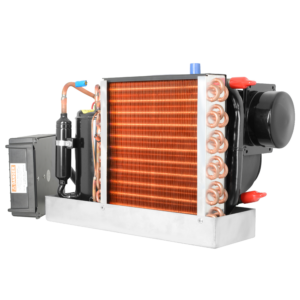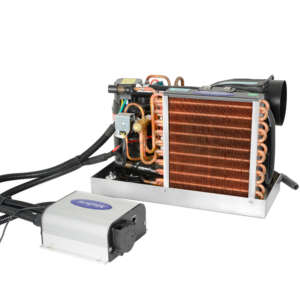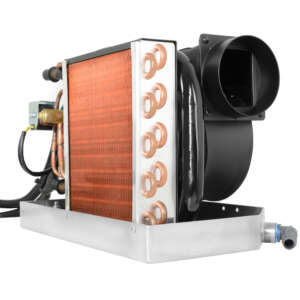For the majority of our Gulf Coast customers, on board comfort during the hot summer months is critical to getting full use out of their boats. Convenient, reliable Air Conditioning is an important development in marine technology and has taken several steps forward over the last few years. Many of the major manufacturers now offer this as a factory option in their larger models. Since most major manufacturers of new boats do not always specifically target warmer climate zones in production, many boats make their way to the Gulf Coast without ever getting outfitted with air conditioning systems.
While there are plenty of aftermarket options for shore-power air conditioning, these can be inconvenient, bulky, and aren’t useable when away from the dock.
The alternative to this is running an HVAC unit on the boat’s Direct Current (DC) electrical system.
No Generator Needed
Direct Current Air Conditioning Option is especially sensible on boats that need the advantages of air conditioning but not a genset.
Installing a generator on your boat may not make sense in many scenarios, including:
- The hassle of dealing with generator maintenance, issues, and additional fuel consumption may take away from you and your family’s enjoyment of getting out on the water.
- The noise generated by the unit, often installed nearby a berth, may offset the added comfort of air conditioning when trying to sleep.
- The extra weight added by the generator may be an issue – and could affect the boat’s balance.
- Your projected usage does not reflect the price point
- The added consumption of non-renewable resources (gas for generator) is a concern
Advances in electrical efficiency have allowed for these DC Air Conditioning Systems to run off of 12V lithium ion batteries which are charged by shore power or the engine. This enables your system to still keep your crew comfortable when away from the dock.
Going back to the usage reflecting the price point, we often find that customers who get this option after debating the generator are especially appreciative of the cost/benefit. Boats being used as daysailors or live-aboards alike can integrate perfectly with this system because the air is being run without using up battery capacity when running the engine or connected to shore power. The batteries are simply an added bonus when docked for an evening or overnight.
Aftermarket Direct Current (DC) Air Conditioning Options
These systems can be outfitted in multiple ways, including self-contained units, split systems, and chilled water systems. There are advantages and disadvantages to all options, the decision comes down to what makes sense for your boat’s size & available storage as well as your budget.
Self-Contained Marine Air Conditioning Unit
These HVAC units are compact, convenient systems fueled by refrigerant and typically are used for 1-2 rooms. One major advantage of this option is the efficiency in both electricity and space. It is much easier to find a serviceable location on board for a self contained unit, and requires minimally invasive installation for wiring and plumbing. The unit also has the capacity of reverse-cycle heat and is outfitted with an antimicrobial military copper evaporator.
Split System Marine Air Conditioning
Split System Marine HVAC systems are the most similar to home A/C – used to cool multiple rooms, major components are split between two units connected by insulated copper tubing
Chilled Water Marine Air Conditioning
Chilled Water Marine A/C is typically used for large boats and utilizes freshwater that is pumped around a piping loop to cool or warm the cabin. These systems are typically installed from the factory.



FAQ’s for Marine Air Conditioning:
These Mabru Power Units run off of Direct Current (DC) so with the use of an engine alternator, the A/C system will run off of the engine’s power output.
For the winter months, this option can also be used to heat your boat’s cabin. This is done through a reverse cycle, and warmed air will exit via the same ducts.
Typically, a single self contained heating and cooling system will run about half of the cost of a full generator.
The main 3 types of systems are self-contained units, split systems, and chilled water systems. Self-contained units units are compact, convenient systems fueled by refrigerant and typically are used for 1-2 rooms. Split systems are the most similar to home A/C – used to cool multiple rooms, major components are split between two units connected by insulated copper tubing. Lastly, the chilled water system is used for large boats and utilizes freshwater that is pumped around a piping loop to cool or warm the cabin.
Contact Murray Yacht Sales for a quote on outfitting your New or Brokerage boat with the newest in Marine Air Conditioning Technology.
Contact Us
"*" indicates required fields
